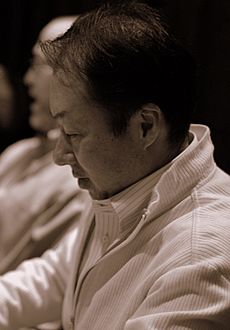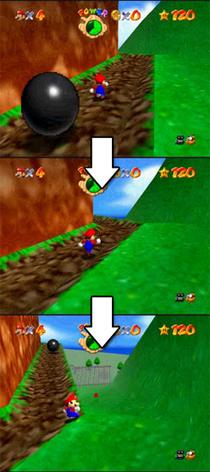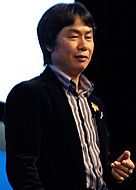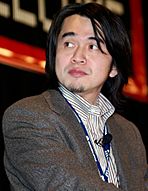Super Mario 64 facts for kids
Quick facts for kids Super Mario 64 |
|
|---|---|

North American cover art
|
|
| Developer(s) | Nintendo EAD |
| Publisher(s) | Nintendo |
| Director(s) | Shigeru Miyamoto |
| Producer(s) | Shigeru Miyamoto |
| Designer(s) |
|
| Programmer(s) |
|
| Artist(s) |
|
| Writer(s) | Leslie Swan |
| Composer(s) | Koji Kondo |
| Series | Super Mario |
| Platform(s) | Nintendo 64 iQue Player |
| Release date(s) | Nintendo 64
|
| Genre(s) | Platform |
| Mode(s) | Single-player |
Super Mario 64 is a fun platform game made by Nintendo for the Nintendo 64 console. It came out in Japan and North America in 1996, and in other parts of the world in 1997. This game was a big deal because it was the first Super Mario game to use 3D! It mixed the classic Super Mario style and characters with a huge, open world.
In the game, Bowser, Mario's main enemy, takes over Princess Peach's castle. He hides the castle's special Power Stars inside magical paintings that lead to different worlds. As Mario, your job is to collect these Power Stars. Collecting enough stars helps you unlock more of Princess Peach's castle. This lets you finally reach Bowser and rescue Princess Peach.
The game's director, Shigeru Miyamoto, first thought about a 3D Super Mario game while working on Star Fox in 1993. Making Super Mario 64 took almost three years. The team spent about a year just planning the game. Then, they spent twenty months actually making it. They started by designing the virtual camera system, which was very new at the time. They also worked hard on creating 3D character models and making Mario's movements look smooth. Koji Kondo created the music for the game.
Super Mario 64 was a highly anticipated game. People were very excited about it, thanks to advertising and showings at the 1996 E3 event. When it came out, critics loved it! They praised its big ideas, amazing graphics, and fun gameplay. Some people did find the camera system a bit tricky at times. It became the best-selling Nintendo 64 game, selling almost twelve million copies by 2015.
Many people still think Super Mario 64 is one of the greatest video games of all time. It greatly influenced other 3D platform games. Its camera system and 360-degree analog control set new standards for the genre. It was like how Super Mario Bros. changed side-scrolling games. The game was later remade as Super Mario 64 DS for the Nintendo DS in 2004. It has also been available on other Nintendo consoles since then. Fans still love the game, creating their own versions and challenges. Some even try to beat the game without pressing the A button! This shows how much they understand the game's secrets.
How to Play Super Mario 64
Game Controls
Super Mario 64 is a 3D platformer where you control Mario through many different levels. Mario can do many more things than in older games. He can walk, run, jump, crouch, crawl, climb, and swim. He can also kick, grab objects, and punch using the game controller's analog stick and buttons.
Mario can perform special jumps by combining actions. These include the double jump, triple jump, long jump, backflip, and wall jump. You can also change the camera view. A character named Lakitu controls the camera. You can switch between seeing through Mario's eyes (first-person) or seeing him from behind (third-person).
Health, Lives, and Power-Ups
Unlike older Super Mario games, Super Mario 64 uses a health system. Mario's health is shown as a pie with eight slices. If Mario gets hurt, he can get his health back. He does this by collecting yellow, red, or blue coins. Yellow coins restore one slice, red coins are worth two yellow, and blue coins are worth five. Walking through a spinning heart also helps.
When Mario is underwater, his health bar shows how long he can hold his breath. It slowly goes down underwater and refills when he reaches the surface. Just like in other Super Mario games, Mario starts with extra lives. He loses a life if his health runs out or if he falls into a deep pit. The game ends if Mario loses all his lives.
You can earn more lives by collecting fifty yellow coins in a level. Special extra life mushrooms are also hidden in places like trees.
This game doesn't have the usual power-ups like the Super Mushroom or Fire Flower. Instead, you'll find three types of see-through blocks: red, green, and blue. You need to find hidden switches of the same colors. Hitting a switch makes its matching blocks solid. Then, Mario can get special cap power-ups from them.
- The Wing Cap lets Mario fly after a triple jump or being shot from a cannon.
- The Metal Cap makes Mario super strong. He becomes immune to enemies, fire, and gas. He can also walk against strong winds and water currents. Plus, he can move underwater as if he were on land and hold his breath forever!
- The Vanish Cap makes Mario partly invisible and untouchable. It also lets him walk through some walls and obstacles.
After stomping a Koopa Troopa, a shell is left behind. Mario can use this shell to surf on water, lava, and quicksand.
Game Setting and Goals
The main area of the game is Princess Peach's Castle. This castle has three floors, a tall tower, and a basement. Outside, there's a moat and a courtyard. Your main goal is to find paintings inside the castle. These paintings are magical portals that take you to different levels. In each level, you need to find Power Stars.
Collecting Power Stars helps you unlock more rooms in the castle. There are fifteen main levels, and each has seven Power Stars to find. There are also fifteen extra Power Stars hidden as secrets or bonuses. This means there are 120 Power Stars in total!
The levels are full of enemies, but also friendly characters. For example, Bob-omb Buddies can help you by letting Mario use cannons. Some Power Stars only appear after you complete certain tasks. The name of the level often gives you a hint about what to do. These tasks might include:
- Collecting one hundred yellow coins in a level.
- Finding eight red coins.
- Defeating a boss.
- Racing against an opponent.
- Solving puzzles.
To reach the final level and fight Bowser, you need at least 70 Power Stars. There are also many hidden mini-levels and secrets inside the castle. These can give you extra Power Stars needed to fully complete the game. If you collect all 120 Power Stars, you can find Yoshi on the roof of Princess Peach's Castle. He will give you a special message, one hundred extra lives, and an improved triple jump!
Game Story
The game starts with a letter from Princess Peach. She invites Mario to her castle for a cake she baked for him. But when Mario arrives, he finds out that Bowser has taken over! Bowser has trapped the princess and her helpers inside the castle. He used the power of the castle's 120 Power Stars to do this.
The Power Stars are hidden in the castle's paintings. These paintings act as portals to other worlds. Bowser's minions guard the stars in these worlds. Mario explores the castle and jumps into these painting worlds. As he gets more stars, he unlocks more rooms in the castle. Mario also finds keys by defeating Bowser in hidden worlds. These keys unlock doors to different floors of the castle.
After getting at least 70 of the 120 stars, Mario can break the spell of the "endless stairs." These stairs block the way to Bowser's final hiding spot. After Mario defeats Bowser in the last battle, Bowser escapes, promising to get revenge. Mario gets a special Power Star that gives him the Wing Cap. He flies back to the castle's courtyard. Princess Peach is freed from the stained-glass window above the castle's entrance. She thanks Mario with a kiss and gives him the cake she promised!
Making the Game: Development Story
In the early 1990s, Shigeru Miyamoto, the creator of Super Mario, started thinking about a 3D Mario game. This idea came to him while he was making Star Fox (1993) for the Super Nintendo Entertainment System. Star Fox used a special chip called Super FX to add more power. Miyamoto thought about using this chip for a Super NES game called Super Mario FX. He imagined a tiny world, like miniature trains.
Miyamoto later decided to make the game for the Nintendo 64. He chose this console not just because it was more powerful, but also because its controller had more buttons. These extra buttons were perfect for the new gameplay ideas. At a big electronics show in 1993, Nintendo showed off a talking 3D Mario head. This cool animation later became the start screen for Super Mario 64.
Work on Super Mario 64 officially began on September 7, 1994. It was made by Nintendo's Entertainment Analysis and Development team. The game was finished on May 20, 1996. Miyamoto said the development team had about fifteen to twenty people.
The team started by working on the characters and the camera system. They spent months choosing the best way to view the game. The first idea was a fixed view, like in Super Mario RPG. But they soon changed it to a free-roaming 3D design. This allowed players to explore more freely.
"There [were] no jumping actions in 3-D we could reference at the time, so we shared in the enjoyment of going through all the trial and error with Mr. Miyamoto and other team members. It was arguably tough work, but that feeling was overtaken by the joy of innovating in a new field."
Super Mario 64 was one of the first Nintendo games where the artwork was made completely in-house. The graphics were created using a special tool called N-World. The team focused a lot on Mario's movements. Before they even built the levels, they tested and perfected Mario's animations on a simple grid.
Creating 3D animations was a new challenge. Yoshiaki Koizumi, the co-director, said it was tough because there were no examples of 3D jumping actions to follow. But he also said it was exciting to create something new. To help players see depth, the team put a fake shadow directly under each object. This made it easier to tell where things were, even if it wasn't perfectly realistic.
Miyamoto wanted the game to have more details than earlier games. He used the Nintendo 64's power to show "all the emotions of the characters." He said the game's style was like an interactive 3D cartoon. Some ideas came from the developers' own lives. For example, the Boos (the ghost enemies) were inspired by assistant director Takashi Tezuka's wife. Miyamoto joked that she was usually quiet but sometimes "exploded" when Tezuka spent too much time at work!

The game's music was composed by the famous Koji Kondo. He made new versions of classic Mario tunes and also created new songs. Yoji Inagaki was in charge of the sound effects. He had to make hundreds of different sounds for the game. Both Kondo and Inagaki believed that music and sound effects were equally important for the game.
Super Mario 64 was one of the first games to feature Charles Martinet as the voice of Mario. Leslie Swan, who worked on Nintendo Power magazine, voiced Princess Peach.
Game Release and Sales
Super Mario 64 was first shown as a playable test version in November 1995. This early version was only half-finished. Only about two percent of the textures (the images that cover 3D models) were done. It had thirty-two levels. Miyamoto hoped to have even more, maybe up to forty, but they ended up with fifteen.
Nintendo decided to delay the Nintendo 64's release from Christmas 1995 to Summer 1996. This was partly because Miyamoto wanted more time to add things to Super Mario 64. Nintendo's president, Hiroshi Yamauchi, said that game creators can finish games quickly if they cut corners. But he believed players would notice if the game wasn't perfect. So, he gave Miyamoto two more months. The game was later shown at E3 1996, where many Nintendo 64 consoles were set up for people to play.
Advertising and Sales Success
Nintendo saw Super Mario 64 as the main reason people would buy the Nintendo 64. They spent $20 million on advertising. This included sending videotapes to over five hundred thousand Nintendo Power magazine subscribers. They also showed ads on TV channels like MTV, Fox, and Nickelodeon.
Super Mario 64 was officially released in Japan in June 1996. It came out in North America in September and in Europe and Australia in March 1997. In its first three months in North America, it sold over two million copies. It made $140 million in the United States, becoming the best-selling video game of 1996. It was also the best-selling game overall from 1995 to 2002.
By March 2008, Super Mario 64 had sold 11.8 million copies worldwide. This made it the best-selling Nintendo 64 game ever. By 2015, it was the 12th most sold Mario game, with 11.91 million copies sold.
New Versions and Re-releases
Super Mario 64 DS
An improved version, Super Mario 64 DS, was released for the Nintendo DS in 2004. Like the original, the story is about collecting Power Stars and saving Princess Peach from Bowser. But in this version, you start as Yoshi. Mario, Luigi, and Wario can be unlocked later.
This remake had better graphics and slightly changed levels. It also added new areas, power-ups, and enemies. There were more Power Stars to collect, mini-games using the touchscreen, and a multiplayer mode. Most reviews were positive. Critics liked the graphics and new features. However, some found the controls and multiplayer mode a bit difficult. By September 2021, 11.06 million copies had been sold worldwide.
Other Ways to Play
Super Mario 64 has been released on other Nintendo systems too.
- In late 2006, it was released on the Wii Virtual Console. This version had better graphics and worked with GameCube and Classic controllers.
- In September 2020, Super Mario 64 was part of the Super Mario 3D All-Stars collection on Nintendo Switch.
- It appeared again on Nintendo Switch in October 2021. This was as part of the Nintendo 64 games available for the Nintendo Switch Online + Expansion Pack.
Game's Lasting Impact
[...] if the gaming press was to be believed, Super Mario 64 was going to be the greatest game ever released anywhere, and it might also cure cancer and feed the world's starving children.
The rule that a console must have a broad spectrum of launch titles to appeal to the North American audience was generally true, but Nintendo found the exception: a single amazing title, with well-implemented 3D gameplay that most console players had never experienced, could bear the weight of the entire system on its shoulders.
Super Mario 64 was very important for the early success of the Nintendo 64. Many people were excited about the game. It showed that one amazing game could make a console popular, even without many other games at launch.
In 2012, Super Mario 64 was chosen as one of 80 games for an exhibit. This exhibit, called The Art of Video Games, was at the Smithsonian American Art Museum.
How it Influenced Other Games
Super Mario 64 set many new standards for 3D platformers. It is known for its open-world design, which lets players explore freely. This freedom was praised by game developers and journalists. The game's central hub world, which acts as a safe tutorial and level selector, is now a common feature in 3D platformers.
The game's level design, which focused on missions, inspired other game creators. For example, the makers of GoldenEye 007 (1997) and Tony Hawk's Pro Skater were influenced by it. Dan Houser, who helped create the Grand Theft Auto series, said that any 3D game developer who claims they haven't learned from Mario or Zelda on the Nintendo 64 is lying.
Super Mario 64 also introduced a new kind of camera. This camera could move freely and be controlled by the player. It would turn and speed up based on what Mario was doing. This camera system became the standard for 3D platformers. Nintendo Power magazine praised the game's camera movements. They said it, along with The Legend of Zelda: Ocarina of Time's lock-on camera, were pioneers for the 3D gaming era.
The game's use of the analog stick was also groundbreaking. It allowed for much more precise and varied movements than the digital D-pads on other consoles. Mario's controls were fully analog. This meant you could move him in a full 360-degree range. This allowed for subtle controls, like changing his running speed. In 2005, Electronic Gaming Monthly called Super Mario 64 the most important game since they started publishing. They said it was the first 3D game to get the controls just right.
In July 2021, a perfect, sealed copy of Super Mario 64 was sold at auction for $1,560,000. This was the most money ever paid for a video game. An expert from Heritage Auctions said it's hard to overstate how important this game is to the history of Mario, Nintendo, and video games in general.
Future Mario Games
A sequel to Super Mario 64 was planned. It was called Super Mario 128. However, this project was canceled. This was because it wasn't making enough progress. Also, the Nintendo 64 Disk Drive, which it was planned for, didn't sell well.
Later Super Mario games built on the ideas from Super Mario 64. These include Super Mario Sunshine for the GameCube and Super Mario Galaxy for the Wii. They kept the core design of power-ups and open 3D gameplay. Super Mario Galaxy 2 even has a remake of Super Mario 64's Whomp's Fortress level, called Throwback Galaxy.
The Nintendo Switch game Super Mario Odyssey went back to the open design of Super Mario 64. It has many nods to the older game. You can buy a Mario 64 Suit and Cap. These change Mario's look to how he appeared in Super Mario 64. You can also visit the Mushroom Kingdom, which includes Princess Peach's Castle. The Power Moons in Super Mario Odyssey look like the Power Stars from Super Mario 64.
Game Secrets and Fan Creations
After the game came out, many rumors spread. The most popular one was that Luigi could be unlocked as a playable character. In 1996, IGN even offered $100 to anyone who could find Luigi, but no one ever did. This rumor was fueled by a blurry message on a statue in Princess Peach's Castle courtyard. People thought it said "L is real 2401." But in 1998, Nintendo confirmed it was just a joke by the programmers. In 2020, unused files for Luigi from a scrapped multiplayer mode were found in the game's development files.
Funny conspiracy theories about the game became popular in 2020. These were grouped into the "Super Mario 64 iceberg" meme. The less likely theories were at the bottom of the "iceberg." One popular rumor was about a "Wario Apparition." This was based on an E3 1996 presentation where Charles Martinet voiced a floating Wario head. Some fans believed this Wario head was hidden in some copies of the game. Other theories claimed that "every copy of Super Mario 64 is personalized." This meant that strange things would only happen in certain copies of the game.
Over the years, players have found ways to use glitches to reach new parts of the game. In 2014, someone even collected a coin that wasn't meant to be picked up! Speedrunning (beating the game as fast as possible) uses many glitches. These include:
- The Lakitu skip, which gets rid of a camera tutorial message.
- The Bob-omb clip, which lets Mario go through walls using a Bob-omb's explosion.
- The backwards long jump glitch, which makes Mario go super fast. This glitch was fixed in the 1997 re-release and in Super Mario 3D All-Stars.
Many fans have created their own versions and changes to Super Mario 64:
- Super Mario 64: Chaos Edition is a version that loads codes causing weird things to happen.
- Super Mario Run 64 turns the game into a 2.5D running game, like Super Mario Run.
- Super Mario 64 Online allowed online multiplayer. Nintendo took it down, but it was later re-uploaded as Net64.
- Super Mario 64 Maker is a level editor, like Super Mario Maker.
- Super Mario 64 Odyssey adds levels and mechanics from Super Mario Odyssey.
- Super Mario 64: Last Impact is a new game that uses elements from other Mario games.
- Super Mario 64: Ocarina of Time recreates the world of The Legend of Zelda: Ocarina of Time using Super Mario 64's engine.
- Open World Mario 64 is a battle royale style game with all Super Mario 64 levels combined.
- First Person Mario 64 changes the camera to a first-person view, making the game much harder.
- Super Mario 64 FPS is a first-person shooter remake.
- Super Mario 64 HD was a high-definition remake of the first level, Bob-Omb Battlefield. Nintendo took it down.
- In 2019, fans were able to get the original game's code. This allowed them to make versions for other systems like Windows, Nintendo 3DS, PlayStation 2, and Android.
- Super Mario 64 Plus is an improved version of the Windows port with new features and bug fixes.
- In Rainbow Roads is a music project that recreates the Radiohead album In Rainbows using sounds from Super Mario 64.
Brain Benefits from Playing
In 2013, a study looked at how playing Super Mario 64 affects the human brain. People played the game for at least thirty minutes every day for two months. The study found that this activity made the gray matter in certain brain areas grow. These areas are important for spatial navigation (knowing where you are), working memory, and planning movements.
Images for kids
-
Director Shigeru Miyamoto
-
Composer Koji Kondo
See also
 In Spanish: Super Mario 64 para niños
In Spanish: Super Mario 64 para niños







